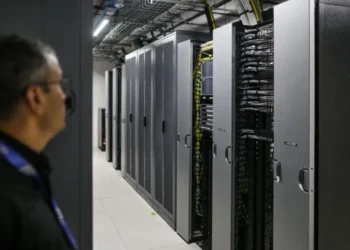The Geopolitical Landscape of the AI Revolution
The locations where industrial revolutions occur can significantly reshape global affairs. Britain’s Industrial Revolution positioned London at the helm of a vast empire, while the digital age began in Silicon Valley, establishing the United States as a leader in technology. If artificial intelligence (AI) sparks the next industrial revolution, it will be uniquely global from the start. In this tumultuous time—arguably the most chaotic since the Cold War—developing the infrastructure to support the AI revolution poses a critical geopolitical challenge for both countries and companies.
AI: A Global Phenomenon
AI is a versatile technology, but unlike previous innovations such as electricity or steam engines, it has spread rapidly, delivering advanced tools like chatbots and image generators almost overnight. The AI sector relies on a complex network of global partners, which includes American and Chinese firms, Taiwan’s semiconductor manufacturers, and critical technologies from the Netherlands. The initial phase of AI competition has focused on cutting-edge semiconductors, but the next phase will hinge on geography and power—specifically, where data centers that drive AI operations can be established, and who possesses the capital and infrastructure to support them.
Data centers are the backbone of the AI ecosystem, converting energy and data into intelligence. Major U.S. tech companies are projected to invest over $600 billion in AI infrastructure, primarily data centers, from 2023 to 2026. Countries that collaborate with these companies to host data centers will gain economic, political, and technological advantages. However, data centers also raise national security concerns, as they often contain sensitive information and high-end, export-controlled semiconductors. While the U.S. leads in many AI areas—especially software and chip design—it faces significant challenges with its data center infrastructure.
The Energy Dilemma
Data is frequently dubbed the “new oil,” but there is a vital distinction when it comes to data centers: while oil reserves are determined by nature, data center locations are a product of national decisions. If the U.S. cannot overcome its domestic bottlenecks, it will need to seek alternatives abroad. The potential for a global AI infrastructure expansion presents an opportunity for governments and businesses to engage in “data center diplomacy.”
Data centers are essential for both the digital economy and AI, yet the pace of their development is stalling. The U.S. hosts the largest number of data centers globally, but its aging energy grid struggles to meet rising demands. Contributing factors include increased electricity consumption, slow infrastructure upgrades, extreme weather events, and the transition to renewable energy. The surge in AI workloads has only exacerbated these vulnerabilities.
Power Supply Challenges
The challenge is not only about how to meet energy needs but also where to do so. The U.S. faces a shortage of land suitable for large-scale data centers—particularly land equipped with the necessary connectivity. Compounding this issue are supply chain problems and lengthy permitting processes for new infrastructure, making it difficult for both public and private sectors to realize their AI aspirations.
The data center power crisis has been building for years, but the rise of AI has accelerated its urgency. For instance, processing a single query in ChatGPT requires nearly ten times more electricity than a Google search. AI models, which perform quadrillions of calculations per second, depend heavily on energy-intensive graphics processing units (GPUs) rather than traditional central processing units (CPUs). This shift is pushing the limits of power efficiency, as modern GPUs demand increasingly high energy levels.
Projections in the energy and technology sectors can be risky, yet the trend is clear: the anticipated energy requirements for future data centers are expected to rise significantly. Goldman Sachs Research estimates that data centers consumed about 3% of U.S. power in 2022, a figure that could reach 8% by 2030. The Federal Energy Regulatory Commission predicts data center consumption will increase from 17 gigawatts (GW) in 2022 to 35 GW by 2030. The International Energy Agency foresees global data center electricity consumption potentially doubling by 2026, largely driven by AI. Such an increase—from 460 terawatt-hours in 2022 to 1,000 terawatt-hours by 2026—would be comparable to Japan’s total electricity usage.
This potential growth could fundamentally alter assumptions about energy grids in the U.S. and other leading economies. Despite economic and population growth, power demand in the U.S. has largely remained stagnant over the past two decades, thanks to efficiency improvements and a shift toward renewable energy sources. However, the escalating energy requirements of data centers present new challenges for outdated electrical grids, which are ill-prepared for rapid and large-scale adaptations.
Meeting AI Demands
Even with sufficient power and connectivity, existing U.S. data centers struggle to accommodate the increasing demands of AI workloads. Most data centers are concentrated in Silicon Valley and Northern Virginia, particularly in Loudoun County, which boasts the highest concentration of data centers globally. However, vacancy rates are at record lows—below 3%—indicating that many facilities are unable to take on additional workloads.
To support future AI workloads, data centers must be equipped to handle high-density energy requirements. Facilities that utilize advanced chips often require liquid cooling, making retrofitting complex and costly. Even if data centers are upgraded, traditional non-AI workloads will still require processing, necessitating additional facilities. In short, the U.S. urgently needs more power and more specialized data centers.
As AI demands intensify, the urgency of the data center crisis escalates. Without adequate power and infrastructure, AI innovation and U.S. competitiveness are at risk.
China’s Strategy
Meanwhile, China is pursuing its own strategy to dominate AI infrastructure. Despite a slowing economy, the country is making significant investments in energy, including the construction of numerous nuclear reactors. In 2023, China accounted for a third of global clean energy investments, even as coal production reached record highs. The government has launched a national data center initiative called “Eastern Data, Western Computing,” which includes a $6.1 billion investment in eight major data center hubs.
The U.S. possesses the resources necessary to compete, being energy-rich and a leading oil producer. A more robust power grid that incorporates diverse energy sources—like nuclear and small modular reactors—could favorably shift market dynamics.
However, having energy reserves doesn’t guarantee that these resources can reach end users efficiently. Connecting energy sources from regions like Texas or North Dakota to data centers requires navigating complex regulatory and permitting processes, which can be capital and time-intensive.
Historically, the U.S. has led energy revolutions, but reforms and innovations are not guaranteed to keep pace with today’s technological and geopolitical demands. Staying ahead is crucial.
The Need for Global Partnerships
Achieving AI independence is unrealistic, especially regarding data centers. AI software requires hardware to operate—raising the question of where this infrastructure will be located. The U.S. must identify partners with the capacity, willingness, and aligned interests to support a secure global data center buildout.
Developing a strategy for data center diplomacy requires awareness of potential risks. Data centers can be vulnerable to cyber threats and espionage, particularly concerning financial and national security data. Historical events, such as the 1973 Arab oil embargo and the COVID-19 pandemic, highlight the dangers of relying on a limited number of foreign partners for critical resources, including data. Geopolitical tensions, like those surrounding Taiwan, could disrupt semiconductor supply chains and hinder the addition of new computing capacity.
Countries are increasingly focusing on domestic control and data localization, leading to movements toward “sovereign AI.” This strategy emphasizes the development of local data center infrastructure, even if it means sacrificing economic efficiency for national resilience. The goal is to expand the market for GPUs beyond the concentrated buyer base seen during the cloud era.
As the U.S. plans its data center strategy, it must evaluate domestic capabilities and identify trustworthy international partners for data center development. Each nation will face tough decisions regarding where to host their AI workloads.
Criteria for Data Center Locations
- National Security: The vulnerabilities in national security and commerce are real, but not every lesson from previous technology competitions is applicable. Although trust, security, and privacy are concerns, the data center situation is not entirely similar to past competitions over technologies like 5G. Unlike the single dominance of companies like Huawei in telecommunications, no single entity controls the future of data centers, with approximately 8,000 data centers built globally by various companies.
- Infrastructure Support: Identifying suitable locations for data centers is critical. Zoning and regulatory frameworks must facilitate efficient infrastructure development. Host nations require access to advanced chips, a topic that has become contentious given China’s AI ambitions and U.S. export controls. Data centers also need high-bandwidth digital connectivity and must operate continuously, necessitating access to reliable and affordable power sources.
- Dynamic Factors: The competitive landscape is ever-changing. Innovations can enhance efficiency and enable new locations for data center development. Energy companies are increasingly employing AI to predict supply and demand fluctuations. Furthermore, advancements in chip design may reduce energy consumption, while large language models often require less bandwidth than traditional internet content, allowing for more flexibility in data center placement.
Many large tech companies are committing to sustainability, aiming for greater reliance on renewable energy sources. However, the current availability of renewable energy often does not meet the consistent needs of data centers. This mismatch raises questions about the feasibility of sustainability commitments amid demands for innovation.
While the list of ideal locations for data centers is limited, it is not nonexistent. Opportunities exist in established democracies, nations straddling the line between U.S. and Chinese influence, and countries aspiring to technology leadership. The U.S. benefits from its technological prowess and partnerships with nations critical to AI’s future, often termed the “AI swing states.”
International Opportunities
Canada, a key U.S. ally and trading partner, plays a significant role in the data center market. The country has ample powered, networked, and developed land. Meanwhile, Europe, with its abundant renewable energy resources, is poised for growth as data centers increasingly seek environmentally friendly solutions.
Countries in Africa and the Global South present further opportunities, as some are eager to enter the global digital economy. Nations like Kenya and Rwanda, which have invested in renewable energy infrastructure, show potential to play a crucial role in the AI landscape.
U.S. firms have the capacity to lead the data center race, but for this to materialize, they must adopt a collaborative, multifaceted approach that embraces innovation while safeguarding national interests. The world is poised at a pivotal moment in history, and the right choices made now could shape the course of AI for generations to come.
This article was rewritten by JournosNews.com based on verified reporting from trusted sources. The content has been independently reviewed, fact-checked, and edited for accuracy, neutrality, tone, and global readability in accordance with Google News and AdSense standards.
All opinions, quotes, or statements from contributors, experts, or sourced organizations do not necessarily reflect the views of JournosNews.com. JournosNews.com maintains full editorial independence from any external funders, sponsors, or organizations.
Stay informed with JournosNews.com — your trusted source for verified global reporting and in-depth analysis. Follow us on Google News, BlueSky, and X for real-time updates.













